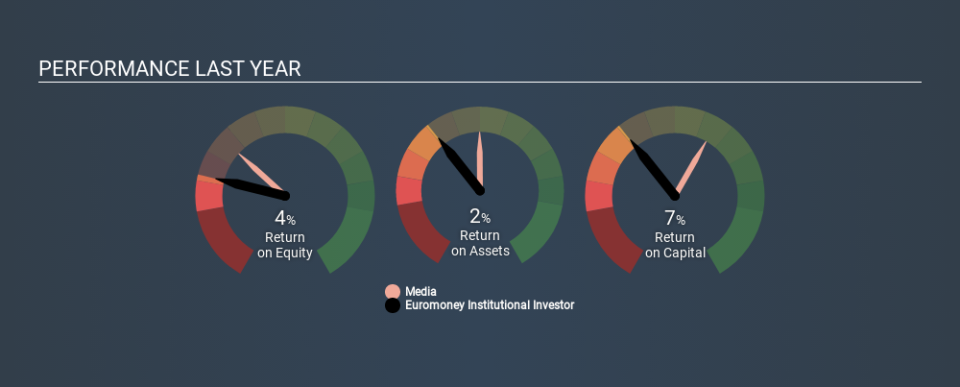Do Euromoney Institutional Investor PLC’s (LON:ERM) Returns On Capital Employed Make The Cut?

Today we'll look at Euromoney Institutional Investor PLC (LON:ERM) and reflect on its potential as an investment. Specifically, we'll consider its Return On Capital Employed (ROCE), since that will give us an insight into how efficiently the business can generate profits from the capital it requires.
First, we'll go over how we calculate ROCE. Second, we'll look at its ROCE compared to similar companies. Finally, we'll look at how its current liabilities affect its ROCE.
What is Return On Capital Employed (ROCE)?
ROCE measures the 'return' (pre-tax profit) a company generates from capital employed in its business. All else being equal, a better business will have a higher ROCE. In brief, it is a useful tool, but it is not without drawbacks. Renowned investment researcher Michael Mauboussin has suggested that a high ROCE can indicate that 'one dollar invested in the company generates value of more than one dollar'.
So, How Do We Calculate ROCE?
The formula for calculating the return on capital employed is:
Return on Capital Employed = Earnings Before Interest and Tax (EBIT) ÷ (Total Assets - Current Liabilities)
Or for Euromoney Institutional Investor:
0.074 = UK£41m ÷ (UK£831m - UK£273m) (Based on the trailing twelve months to September 2019.)
So, Euromoney Institutional Investor has an ROCE of 7.4%.
Check out our latest analysis for Euromoney Institutional Investor
Is Euromoney Institutional Investor's ROCE Good?
When making comparisons between similar businesses, investors may find ROCE useful. It appears that Euromoney Institutional Investor's ROCE is fairly close to the Media industry average of 8.3%. Aside from the industry comparison, Euromoney Institutional Investor's ROCE is mediocre in absolute terms, considering the risk of investing in stocks versus the safety of a bank account. Readers may find more attractive investment prospects elsewhere.
We can see that, Euromoney Institutional Investor currently has an ROCE of 7.4%, less than the 16% it reported 3 years ago. So investors might consider if it has had issues recently. The image below shows how Euromoney Institutional Investor's ROCE compares to its industry, and you can click it to see more detail on its past growth.
When considering this metric, keep in mind that it is backwards looking, and not necessarily predictive. ROCE can be deceptive for cyclical businesses, as returns can look incredible in boom times, and terribly low in downturns. ROCE is, after all, simply a snap shot of a single year. What happens in the future is pretty important for investors, so we have prepared a free report on analyst forecasts for Euromoney Institutional Investor.
What Are Current Liabilities, And How Do They Affect Euromoney Institutional Investor's ROCE?
Current liabilities include invoices, such as supplier payments, short-term debt, or a tax bill, that need to be paid within 12 months. Due to the way the ROCE equation works, having large bills due in the near term can make it look as though a company has less capital employed, and thus a higher ROCE than usual. To counteract this, we check if a company has high current liabilities, relative to its total assets.
Euromoney Institutional Investor has current liabilities of UK£273m and total assets of UK£831m. Therefore its current liabilities are equivalent to approximately 33% of its total assets. Euromoney Institutional Investor's middling level of current liabilities have the effect of boosting its ROCE a bit.
Our Take On Euromoney Institutional Investor's ROCE
Despite this, its ROCE is still mediocre, and you may find more appealing investments elsewhere. Of course, you might also be able to find a better stock than Euromoney Institutional Investor. So you may wish to see this free collection of other companies that have grown earnings strongly.
If you are like me, then you will not want to miss this free list of growing companies that insiders are buying.
If you spot an error that warrants correction, please contact the editor at editorial-team@simplywallst.com. This article by Simply Wall St is general in nature. It does not constitute a recommendation to buy or sell any stock, and does not take account of your objectives, or your financial situation. Simply Wall St has no position in the stocks mentioned.
We aim to bring you long-term focused research analysis driven by fundamental data. Note that our analysis may not factor in the latest price-sensitive company announcements or qualitative material. Thank you for reading.

 Yahoo Finance
Yahoo Finance 
